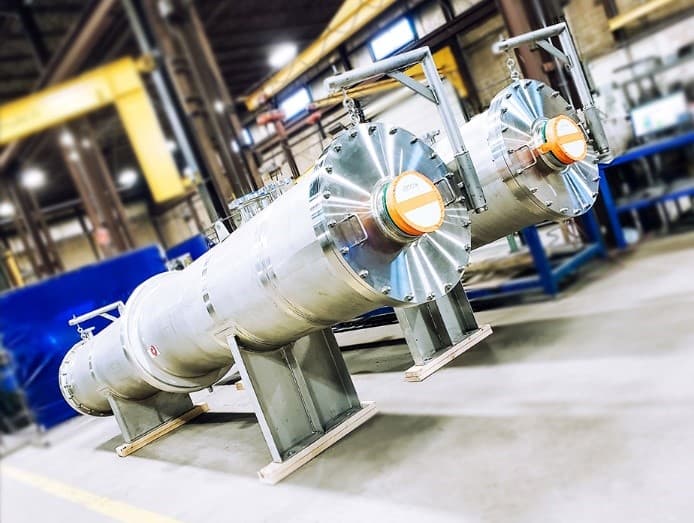The heat transfer fluid (HTF) flowing through your shell and tube heat exchanger plays a large role in determining the effectiveness of your operation. Many options are available for HTFs, including water, steam, mineral oils, silicone-based fluids and glycol-based fluids.
HTFs flow through either the tubeside or the shellside of the shell and tube heat exchanger, while the product being treated flows through the opposite side. The fluid facilitates either the heating or cooling of the product.
Choosing the right HTF for your operation involves many considerations. Here are some key details to know about HTFs:
Cost and Accessibility
HTF selection shouldn’t be entirely based on cost, but this is a key factor to take into account. The fluid you choose should also be easily accessible so that you can replace it when the time comes.
Glycol-based HTFs are popular among many industries and applications for both of these reasons, according to a webinar from Process Heating summarized in the Journal of Applied Mechanical Engineering. Silicone HTFs are also common among many industries, Processing Magazine noted.
Glycol-based HTFs can also be combined with water to reduce the freezing point and increase the boiling point. No other HTF can be diluted with water safely.
Allocation
It’s important to choose wisely when determining whether to allocate your HTF to the shellside or tubeside of your heat exchanger. The most beneficial side is one that provides you with the least risk of cross-contamination, easiest cleaning and the safest operation. However, these factors are dependent on the design of the shell and tube heat exchanger, the application and the type of HTF you’re using.
The tubeside of your heat exchanger is most beneficial if your fluid is:
- High pressure.
- Prone to fouling.
- Corrosive.
- Likely to solidify.
A tube bundle is much easier and less expensive to remove and install than a shell, which often requires the replacement of the whole unit. That means if a fluid corrodes tubes beyond safe use, or solidifies to the point of complete obstruction, the bundle can be removed relatively easily and swapped for a new model.
High pressure fluids are better off on the tubeside because the pressure can be controlled by using smaller diameters. This is much more practically done with tubes than shells, which need to have larger diameters to accommodate the tubes within.
Finally, tubes are generally easier to clean on most shell and tube heat exchanger designs. Because of this, a fouled tube is simpler to remedy than a fouled shell.
If your fluid has a low pressure drop or will condense, it may be better off on the shellside. Pressure drop requirements are easily accommodated with careful shell design and baffle placement. Fluids that are highly viscous are also often allocated to the shellside, as these options tend to have low heat transfer.
Monitoring
Regardless of which HTF you choose, it’s important to regularly inspect its effectiveness regularly. In time, HTFs will degrade, reducing their heat transfer capabilities and increasing risk of damage or corrosion to the heat exchanger.
As the HTF degrades, its viscosity and operating temperature will be impacted. Fluids that are past their prime will be less viscous, meaning it’s more resistant to even flow. Lower viscosities require more energy to pump the HTF through the exchanger.
Continually using degraded fluids will increase the likelihood of the fluid and equipment to overheat. As the fluid decomposes, it may begin to reach higher temperatures, which can damage the product as well as the equipment. Additionally, as the fluid reaches higher temperatures, it will degrade faster.
Carefully Plan Your Shell and Tube Heat Exchanger
Choosing your HTF strategically is important to ensuring a safe, effective and sanitary operation. However, it’s just one component in a much larger puzzle. When designing your shell and tube heat exchanger, it’s important to consider the application, working conditions, material selection and the products that will come in contact with the equipment.
The knowledgeable engineers at Enerquip have broad experience designing and fabricating shell and tube heat exchangers for operations in many industries, including food and beverage, oil and gas, pharmaceutical and more. When you’re determining how to best design your heat exchanger for your operation, reach out to the helpful heat exchange engineers at Enerquip. We can assess your process and all related components, including HTF selection, to design a shell and tube heat exchanger that will benefit your business.

